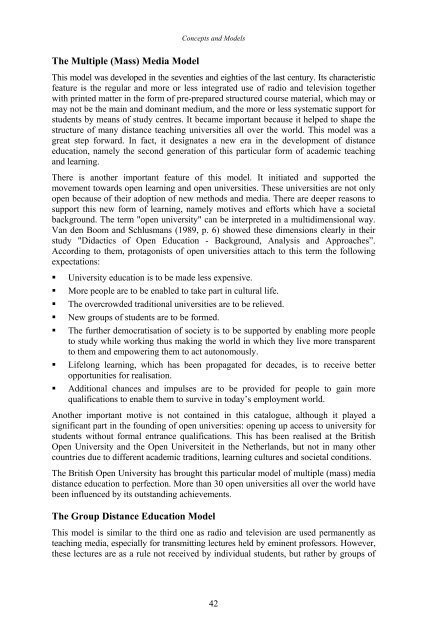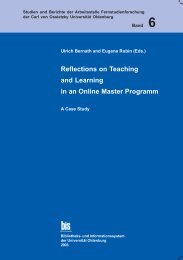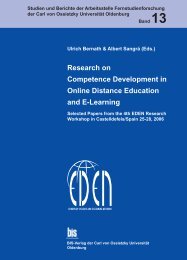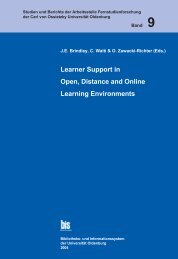Distance Education in Transition - Master of Distance Education ...
Distance Education in Transition - Master of Distance Education ...
Distance Education in Transition - Master of Distance Education ...
You also want an ePaper? Increase the reach of your titles
YUMPU automatically turns print PDFs into web optimized ePapers that Google loves.
The Multiple (Mass) Media Model<br />
Concepts and Models<br />
This model was developed <strong>in</strong> the seventies and eighties <strong>of</strong> the last century. Its characteristic<br />
feature is the regular and more or less <strong>in</strong>tegrated use <strong>of</strong> radio and television together<br />
with pr<strong>in</strong>ted matter <strong>in</strong> the form <strong>of</strong> pre-prepared structured course material, which may or<br />
may not be the ma<strong>in</strong> and dom<strong>in</strong>ant medium, and the more or less systematic support for<br />
students by means <strong>of</strong> study centres. It became important because it helped to shape the<br />
structure <strong>of</strong> many distance teach<strong>in</strong>g universities all over the world. This model was a<br />
great step forward. In fact, it designates a new era <strong>in</strong> the development <strong>of</strong> distance<br />
education, namely the second generation <strong>of</strong> this particular form <strong>of</strong> academic teach<strong>in</strong>g<br />
and learn<strong>in</strong>g.<br />
There is another important feature <strong>of</strong> this model. It <strong>in</strong>itiated and supported the<br />
movement towards open learn<strong>in</strong>g and open universities. These universities are not only<br />
open because <strong>of</strong> their adoption <strong>of</strong> new methods and media. There are deeper reasons to<br />
support this new form <strong>of</strong> learn<strong>in</strong>g, namely motives and efforts which have a societal<br />
background. The term "open university" can be <strong>in</strong>terpreted <strong>in</strong> a multidimensional way.<br />
Van den Boom and Schlusmans (1989, p. 6) showed these dimensions clearly <strong>in</strong> their<br />
study "Didactics <strong>of</strong> Open <strong>Education</strong> - Background, Analysis and Approaches”.<br />
Accord<strong>in</strong>g to them, protagonists <strong>of</strong> open universities attach to this term the follow<strong>in</strong>g<br />
expectations:<br />
� University education is to be made less expensive.<br />
� More people are to be enabled to take part <strong>in</strong> cultural life.<br />
� The overcrowded traditional universities are to be relieved.<br />
� New groups <strong>of</strong> students are to be formed.<br />
� The further democratisation <strong>of</strong> society is to be supported by enabl<strong>in</strong>g more people<br />
to study while work<strong>in</strong>g thus mak<strong>in</strong>g the world <strong>in</strong> which they live more transparent<br />
to them and empower<strong>in</strong>g them to act autonomously.<br />
� Lifelong learn<strong>in</strong>g, which has been propagated for decades, is to receive better<br />
opportunities for realisation.<br />
� Additional chances and impulses are to be provided for people to ga<strong>in</strong> more<br />
qualifications to enable them to survive <strong>in</strong> today’s employment world.<br />
Another important motive is not conta<strong>in</strong>ed <strong>in</strong> this catalogue, although it played a<br />
significant part <strong>in</strong> the found<strong>in</strong>g <strong>of</strong> open universities: open<strong>in</strong>g up access to university for<br />
students without formal entrance qualifications. This has been realised at the British<br />
Open University and the Open Universiteit <strong>in</strong> the Netherlands, but not <strong>in</strong> many other<br />
countries due to different academic traditions, learn<strong>in</strong>g cultures and societal conditions.<br />
The British Open University has brought this particular model <strong>of</strong> multiple (mass) media<br />
distance education to perfection. More than 30 open universities all over the world have<br />
been <strong>in</strong>fluenced by its outstand<strong>in</strong>g achievements.<br />
The Group <strong>Distance</strong> <strong>Education</strong> Model<br />
This model is similar to the third one as radio and television are used permanently as<br />
teach<strong>in</strong>g media, especially for transmitt<strong>in</strong>g lectures held by em<strong>in</strong>ent pr<strong>of</strong>essors. However,<br />
these lectures are as a rule not received by <strong>in</strong>dividual students, but rather by groups <strong>of</strong><br />
42





